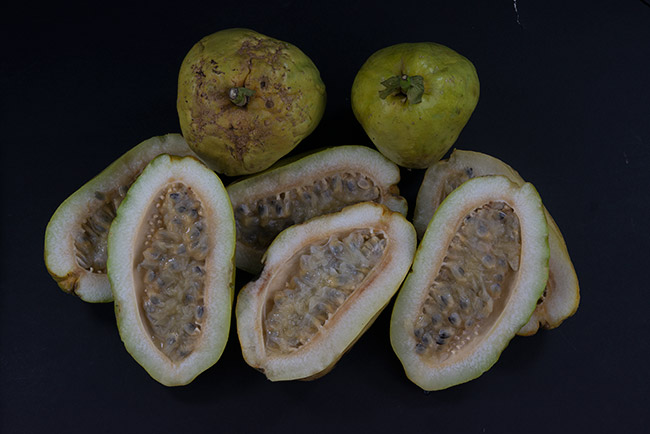Different uses of Passion flower in Mesoamerica
Thousands of passiflora flowers decorate the walls surrounding the FLAAR research center. This plant grows like a weed and tries to take over every square centimeter of space (we like vines like this when their flowers are attractive).
When I first placed my first passion flower seedling, butterfly larva ate the leaves so fast I was afraid I would loose all my plants. But the plant grew faster than the butterfly larva could gobble down the leaves. Today I have tons of vines and lots of happy butterflies too.
Most years the flowers produce fruits but since we do not wish to use any insecticide a variety of insects dig into the fruits and not all reach maturity.

Fruits of maracuya or passion flower. Photographed by Nicholas Hellmuth in FLAAR studio. Date: October 2013.
Passiflora is one of the more common garden vines in the tropics. We have a bright red species and the more aggressive lavender and white flowered species. Neither is native to Guatemala.
Around Chichicastenango there are many plants out in the wild. These produce fruits which are sold in Highland markets. But John MacDougal says these are not native either (even through they are along the highways and not in gardens). So far, in four years search, The first several years we did not find a single passion flower in Guatemala which is native, though John MacDougal says several species and many varieties are very much native to Guatemala.
We list two species as potential sources of flavoring, Passiflora ligularis and Passiflora quadrangularis.
Suzanne Cook has very kindly provided a list of passion flower species which are known by the Lacandon Maya of Lowland Chiapas. Neither Passiflora ligularis nor Passiflora quadrangularis are in her helpful list.

Flowers of maracuya or passion flower. Photographed by Nicholas Hellmuth in Chocol�, San Antonio Suchitepequez. September 2013.
After four years we finally had one vine of produce flowers which in turn produced fruit.
- 1999
- Frutales y condimentarias del tropic h�medo. La Ceiba, Honduras. Centro Regional Universitario del litoral Atl�ntico.
- 1988
- Cultivo y producci�n de Am�rica. Manual de fruticultura (en linea), Caracas Venezuela. Agronegocios, Ministerio de Agricultura y Ganader�a. Gobierno de El Salvador, C. A.
- 1981
- A list of dicotyledoneae of Belize. Rhodora 83(834): 161-236.
- 1996
- O cultivo do maracuj�. Cruz das Almas, Brasil, EMBRAPA. 130 pages. (Circular T�cnica no. 35).
- ND
- Dictionary of Trees, Volume 2: South America: Nomenclature., Volume 2. Eight Passionflower species on page 483-484.
- 2010
- Cultivo y uso de las plantas medicinales y aromaticas: Un camino hacia la salud integral. El hierto medicinal (Taller). Michoacan, Mexico. 80 pages.
Free on the Internet. www.tierramor.org/PDF-Docs/ManualHuertoMed2010.pdf Has only one page on passionflower.
- 2007
- Etnobot�nica Maya, Parque Arqueol�gico Ruinas de Cop�n.
http://www.inbio.ac.cr/web-ca/biodiversidad/honduras/Reporte%20Etnobot%C3%A1nica%20Maya%20Cop%C3%A1n%20PH.pdf
- 1996
- Cultivo del maracuy�. Managua, Nicaragua. 24 page. (Gu�a Tecnol�gica 8).
- 2004
- Northern Lacandon Maya Medicinal Plant Use in the Communities of Lacanja Chan Sayab and Naha�, Chiapas, Mexico.
- 1936
- Passifloraceae of the Mayan region. Carnegie Inst. Washington Pub. 461. Maya Botany: Miscellaneous papers XIII: 299-328.
- 1938
- The American Species of Passifloraceae. Publ. Field Mus.Nat.Hist. Bot.Ser. 19, 613 pages.
- ND
- Edible Medicinal And Non-Medicinal Plants. Vol. 4, fruits. Very expensive (a polite way of saying over-priced).
- 2011
- Antioxidant acitivity and phenolic compounds in three species of Passifloraceae (Passiflora edulis, P. incarnate, P. liguraris) from Guatemala. ISHS. Acta Horticulturae 964: International Symposium on Medicinal and Aromatic Plants IMAPS2010 and History of Mayan Ethnopharmacology IMAPS.
http://www.actahort.org/books/964/964_11.htm
- 1981
- Fruticultura tropical: 1, maracuy�. S�o Paulo, Brasil, Agron�mica Ceres. 39-61 pages.
- 1966
- Vegetative Key to the Passionflowers of Belize. Internet.
No photographs; no images of any flowers (only drawings of leaves).
http://biological-diversity.info/Downloads/passifl.pdf
- 1987
- Fruits of warm climates. Julia F. Morton, Miami, FL.
- 2003
- Informe Final Proyecto: B�squeda, Colecta y Caracterizaci�n de cultivares de Granadilla de Costa (Passiflora quadrangularis) en la Zona Sur Occidental de Guatemala. Mazatenango, Guatemala. Universidad de San Carlos de Guatemala Direcci�n General de Investigaci�n -DIGICENTRO- UNIVERSITARIO DE SUR OCCIDENTE. 56 page.
- 1936
- The Forests and Flora of British Honduras. Field Museum of Natural History, Publication 350, Botanical Series, vol. 12. 433 pages.
- 1961
- The Forests and Flora of British Honduras. Field Museum of Natural History, Publication 350, Botanical Series, vol. 12. 433 pages.
- 1996
- Cultivo de frutales nativos amazonicos. Amazonia, biodiversidad, comunidades y desarrollo. Passiflora quadrangularis (en l�nea). Universidad nacional de la amazonia peruana. Per�.; consultado el 15 de agosto de 2014.
Web sites on Passiflora quadrangularis
- http://blog.inbio.ac.cr/editorial/?p=105
Just a bit of info, but one nice side view of the remarkable flower.
- www.siap.sagarpa.gob.mx Servicio de Informaci�n y Estad�stica Agroalimentaria y Pesquera SIAP, SIACON, SAGARPA. Consulta de Indicadores de Producci�n Nacional de Maracuy�.
- www.medicinatradicionalmexicana.unam.mx
Surprisingly lists only four passionflower species, mostly for San Luis Potosi.
� Passiflora coriacea Juss.
� Passiflora exsudans Zucc.
� Passiflora foetida L.
� Passiflora suberosa L.
Almost nothing listed for the Maya area. I am surprised at the absence of so many important species for the Maya area.
First posted August 2014.